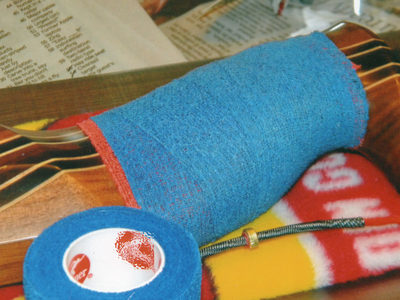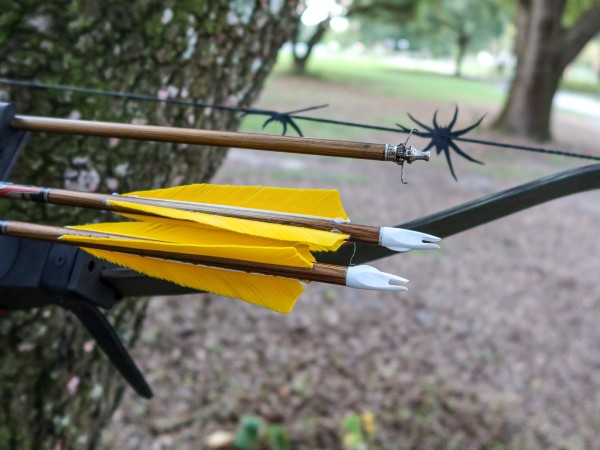I was cow-calling for a bull elk one September day deep in the bottom of a canyon. While there was daylight on the canyon rim 500 feet above, evening had come early to where I sat. I was well hidden in a little copse of saplings that grew by a meandering, almost silent creek. My recurve was within reach, propped upright against a branch, arrow nocked. A distant nighthawk made frequent, electric “peenting” sounds while he flew far above. I enjoy these evening melodies and watching the thickening shadows, but at the same time, I usually get a tense feeling deep in the pit of my stomach. These nerves probably arise from being far from camp and the comfort of a fire, knowing I have a long hike out behind the beam of a headlamp.
Listening to the nighthawk far above took me back to some of my ornithology classes in college. I recalled the nighthawk’s Latin order name meant “goat sucker,” as it was once thought to have sucked the milk from goats’ udders. Some cultures held the belief that the souls of the dead came back in the form of the bird to suck the blood and bones from humans, leaving just the flesh behind.
Shadows were growing on the canyon walls. The two caves above me turned black, looking like empty, soulless eyes. It was then I heard the scream. The sound was coming from one of those black caves above. I quickly searched with my binoculars but couldn’t make out the form of any creature. It took me a few moments to place the noise as that of a screech owl. Grabbing my camera I kept at my side, I rose from my concealment. I knew by searching for the bird, I may be blowing a chance at an elk, but I hadn’t received any responses from a bull since I had set up. The owl continued its screeching, but it took some searching to find him. The mottled bars and blotches on his feathers were a perfect match for the colors of the granite in which he nestled; only the owl’s huge amber eyes gave him away. Those slowly blinking eyelids gave a false aura of indifference; I knew he was keenly aware of my actions. I quickly mounted my camera on my trekking pole, which also serves as a monopod. My telephoto lens allowed me to keep a good distance away without flushing him and there was just enough light to get a few decent shots.
On the hike out of the canyon, my headlamp beam bobbed and weaved over the game trail like a boxer trying to avoid a punch from some unseen opponent. The night had chilled enough to send the steam from my breath into the light. Even with the cold, I began to overheat as I hiked the steepening trail. Removing my hat to cool down, I could hear the now distant call of the owl. I thought about my decision to go after that photograph and came to the realization that I’m an opportunistic photographer. While my primary quarry may be a bull elk, I’m prepared, should clouds turn red with the setting sun, or a bald eagle soars on the thermals above, to capture those images on my camera.

A fiery red sunrise greets the author on a Wyoming bowhunt.
As bowhunters, we have the perfect opportunity to combine our passion with photography, whether that be wildlife or landscape photography. It doesn’t necessarily require sophisticated equipment. Even a point- and-shoot camera or a cell phone can take some respectable pictures. However, an investment in a decent camera body and lens will produce a noticeable difference in the quality and clarity of the images captured.

Even an inexpensive point and shoot camera can capture thrilling moments of a traditional bowhunt.
One of the joys I gained in switching from a compound bow to a recurve, many years ago, was the intrinsic beauty and lightness of the traditional bow. I remember heaving the weighty compound from shoulder to shoulder as the day wore on, and the bow increasing exponentially in weight with the distance I walked. Hunting with a recurve after a couple of years of toting around the compound gave me the feeling a chronic smoker must feel when he kicks the habit and can finally breathe again. I didn’t want to simply trade the weight of a compound for that of heavy camera gear. I’ve found the proper gear to take extreme close-up photos or long distance shots while keeping the bulk and weight down.

A lonely bull stopped by a fence as he spies the author’s cow elk decoy.
Depending on the make and model of a camera body, it can be lightweight and still offer the photographer the ability to take control of the settings without being hogtied by what the camera dictates. Manual settings can be a bit intimidating at first. With practice they become second nature, giving the photographer the freedom to be creative. The auto settings are useful as well. If I hand my camera to a buddy to take my picture, I set it to full auto so all he needs to do is point and shoot.

The author’s camera gear can handle a wide range of photographic opportunities, from close-ups to long-distant shots.
The standard kit lenses that most digital SLR cameras come with are lightweight and perfect for landscape shots or photos of your hunting partner posing with a trophy. The one I carry has a focal length of 18mm – 50mm making it a good general purpose lens. This is my go-to lens for most of the hunting experiences I encounter.
I invested in a professional quality 100mm – 400mm which takes great shots of distant wildlife. It also keeps me safely removed from dangerous critters like grizzlies or rattlesnakes. However, the lens weighs about as much as my son did when he was born. It is just too heavy and cumbersome to carry while I’m bowhunting. Because of this, I carry a lighter weight 100mm – 300mm lens in my hunting daypack which, while not being as high quality, still takes some great images. I also carry a small 2x extender or teleconverter, in effect giving me a 200mm – 600mm lens.
The extenders, as the name suggests, extend the focal length of a lens (the longer the focal length, the higher the magnification). The extender attaches between the lens and the camera body, and most allow for electronic focusing or image stabilization if your camera and lens have that capability. They are compact and relatively lightweight. Using the extender on the 18mm – 50mm lens will give great portrait opportunities when dialed to 70-90mm. It is worth spending the extra money on a high-quality extender, as skimping can result in some fuzzy pictures.
While the extenders allow me to reach out and capture an image of a grizzly bear at a safe distance, extension tubes transport me into the world of macro photography. Extension tubes are inexpensive, hollow, lightweight tubes that attach between the lens and camera body. These tubes extend the lens a distance from the camera body, allowing you to get the lens closer to your subject. The closer you can focus on the subject, the more the magnification increases. The tubes allow you to get close-up pictures like that of a macro lens, without the weight of a true macro lens. Since there is no optical glass in the tubes, they are a much more affordable option. This tiny world we most often ignore can offer some unique photographic images.

There is beauty all around a bowhunter, including this colorful tent caterpillar inching his way along a twig.
If I have my spotting scope with me, I carry a tripod. The tripod is obviously great for keeping camera shake to a minimum, and it is great when there is no one around to snap a photo when I am lucky enough to harvest an animal. As my knees aren’t getting any younger and those downhill paths give them a pounding, a trekking pole is a constant companion. I carry a trekking pole with a built in adapter on top of the handle that allows for mounting cameras. If I should leave the scope and tripod back in the truck, I use my trekking pole to help minimize camera shake. I also carry a small tilt head attachment that screws onto the thread on the monopod. This allows for a nice range of motion and gives good, steady control of the lens. Those screech owl pictures I took turned out sharp in large part due to the use of the trekking pole and tilt head I used.
Like a watercolor artist who sees subtle colors and hues that others may not notice, the world of photography reveals composition of shapes and patterns in nature. The creek I once hopped over with scarcely a thought now reveals the crooked lines of a brown trout in the sunlight-streaked shallows. The tent caterpillar inching along a twig of a bitterbrush now appears huge in my viewfinder, revealing colorful patterns tattooed on the segmented, pincushion-like body. While my autumn bowhunts focus on taking a big game animal, my experience is enriched and memories are saved by capturing nature’s images through the lens of a camera when the opportunity arises.

Hiding in plain sight, a brown trout awaits a meal.
Sidebar:
I use Canon lenses and bodies, but there are many fine options out there. Like the debate between Chevy and Ford owners, brand loyalty comes down to personal preferences. I have a Canon 7D body and several Canon lenses. Lately, I have been using Tamron lenses, a lower-priced, but good quality lens. Like traditional bowhunting, becoming proficient at photography takes time. I keep the words of the great American black and white photographer, Ansel Adams, in mind when taking pictures: “A good photograph is knowing where to stand.”







Excellent points! To lighten one’s load I suggest a good look at the Sony RX10 IV. Superb image quality (I have the RX 10 II). 24-600mm f2.4/4 Zeiss optics (sharp at all focal lengths!), in-body image stabilization, and 4K video if one is so inclined.